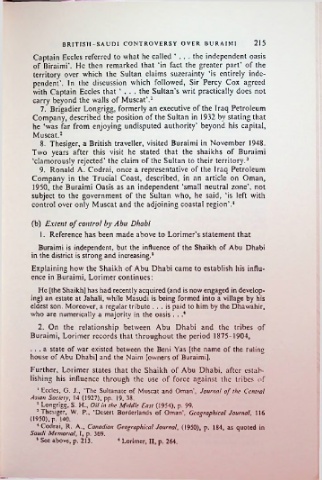Page 277 - The Arabian Gulf States_Neat
P. 277
BRITISH-SAUDI CONTROVERSY OVER BURAIMI 215
Captain Ecclcs referred to what he called 4 ... the independent oasis
of Biraimi'. He then remarked that ‘in fact the greater part1 of the
territory over which the Sultan claims suzerainty ‘is entirely inde
pendent'. In the discussion which followed, Sir Percy Cox agreed
with Captain Ecclcs that ‘ the Sultan's writ practically does not
carry beyond the walls of Muscat'.1
7. Brigadier Longrigg, formerly an executive of the Iraq Petroleum
Company, described the position of the Sultan in 1932 by stating that
he ‘was far from enjoying undisputed authority’ beyond his capital,
Muscat.2
8. Thesiger, a British traveller, visited Buraimi in November 1948.
Two years after this visit he stated that the shaikhs of Buraimi
‘clamorously rejected’ the claim of the Sultan to their territory.3
9. Ronald A. Codrai, once a representative of the Iraq Petroleum
Company in the Trucial Coast, described, in an article on Oman,
1950, the Buraimi Oasis as an independent ‘small neutral zone’, not
subject to the government of the Sultan who, he said, ‘is left with
control over only Muscat and the adjoining coastal region’.1
(b) Extent of control by Abu Dhabi
1. Reference has been made above to Lorimer's statement that
Buraimi is independent, but the influence of the Shaikh of Abu Dhabi
in the district is strong and increasing.5
Explaining how the Shaikh of Abu Dhabi came to establish his influ
ence in Buraimi, Lorimer continues:
He [the Shaikh] has had recently acquired (and is now engaged in develop
ing) an estate at Jahali, while Masudi is being formed into a village by his
eldest son. Moreover, a regular tribute ... is paid to him by the Dhawahir,
who are numerically a majority in the oasis . . .®
2. On the relationship between Abu Dhabi and the tribes of
Buraimi, Lorimer records that throughout the period 1875-1904,
. . . a state of war existed between the Beni Yas [the name of the ruling
house of Abu Dhabi] and the Naim [owners of Buraimi].
Further, Lorimer states that the Shaikh of Abu Dhabi, after estab
lishing his influence through the use of force against the tribes of
1 Ecclcs, G. J., ‘The Sultanate of Muscat and Oman', Journal of the Central
Asian Society, 14 (1927), pp. 19, 38.
2 Longrigg, S. H., Oil in the Middle East (1954), p. 99.
3 Thesiger, W. P., ‘Desert Borderlands of Oman’, Geographical Journal, 116
(1950), p. 140.
* Codrai, R. A., Canadian Geographical Journal, (1950), p. 184, as quoted in
Saudi Memorial, I, p. 369.
5 Sec above, p. 213. 8 Lorimer, II, p. 264.

